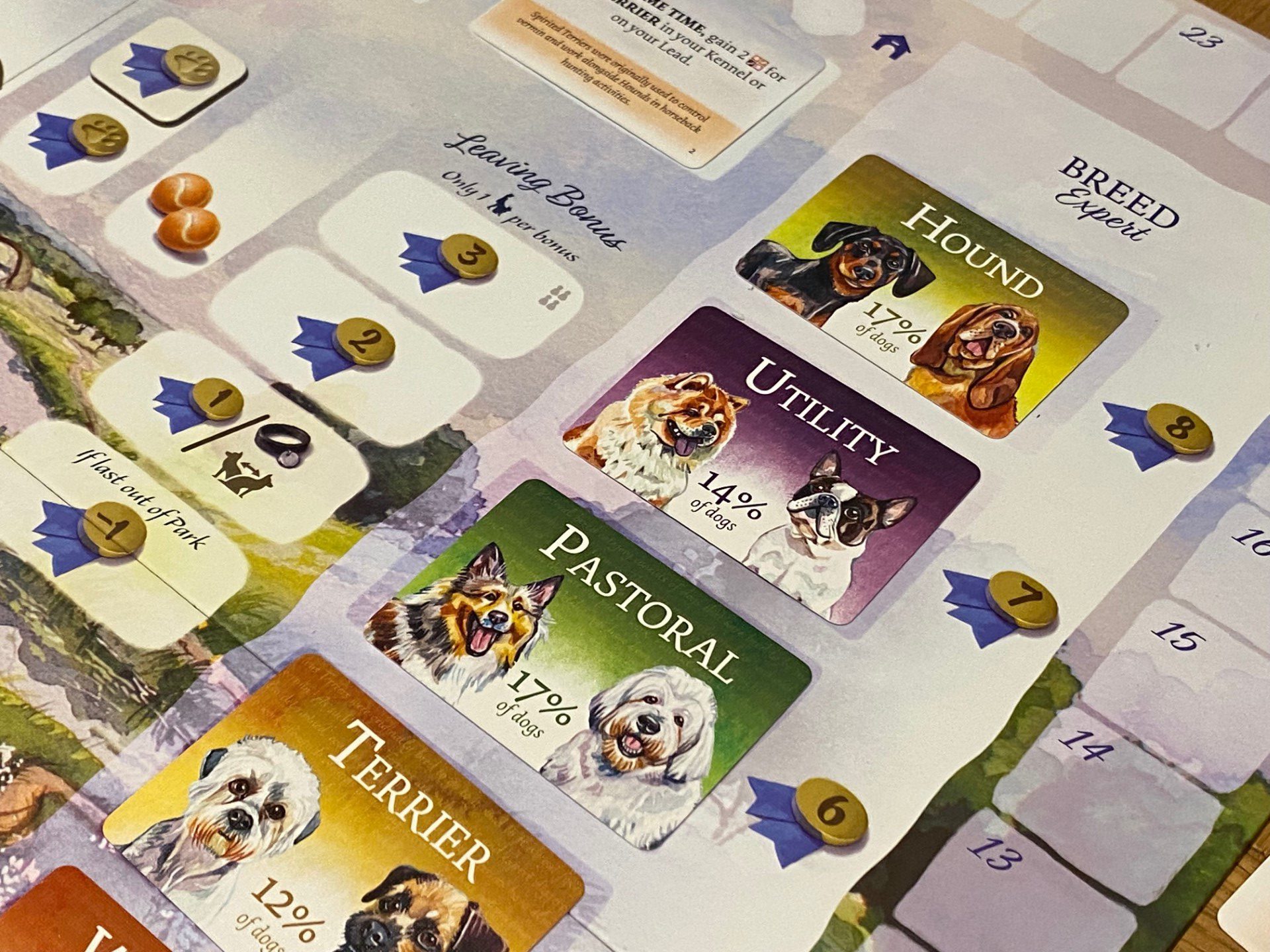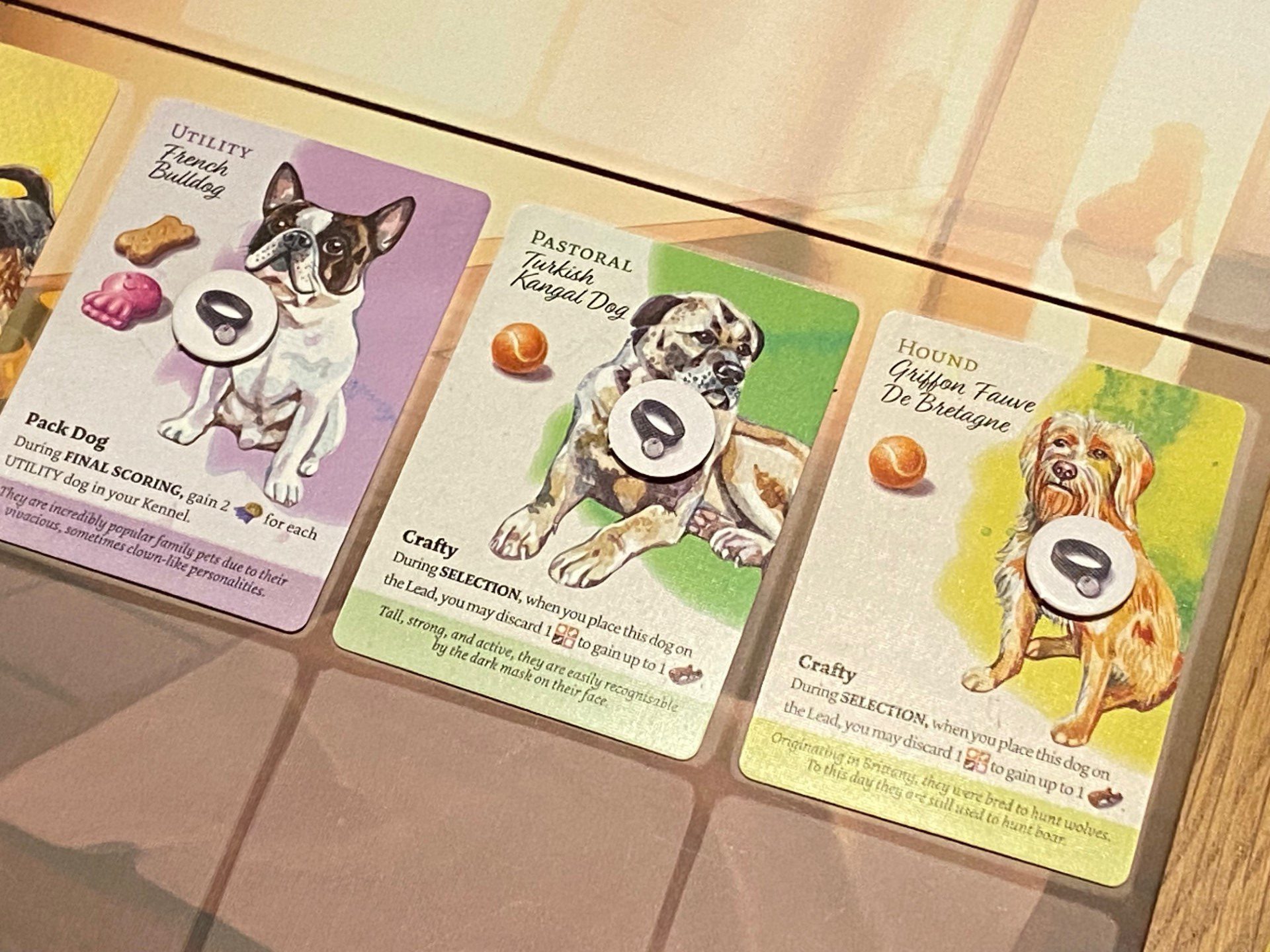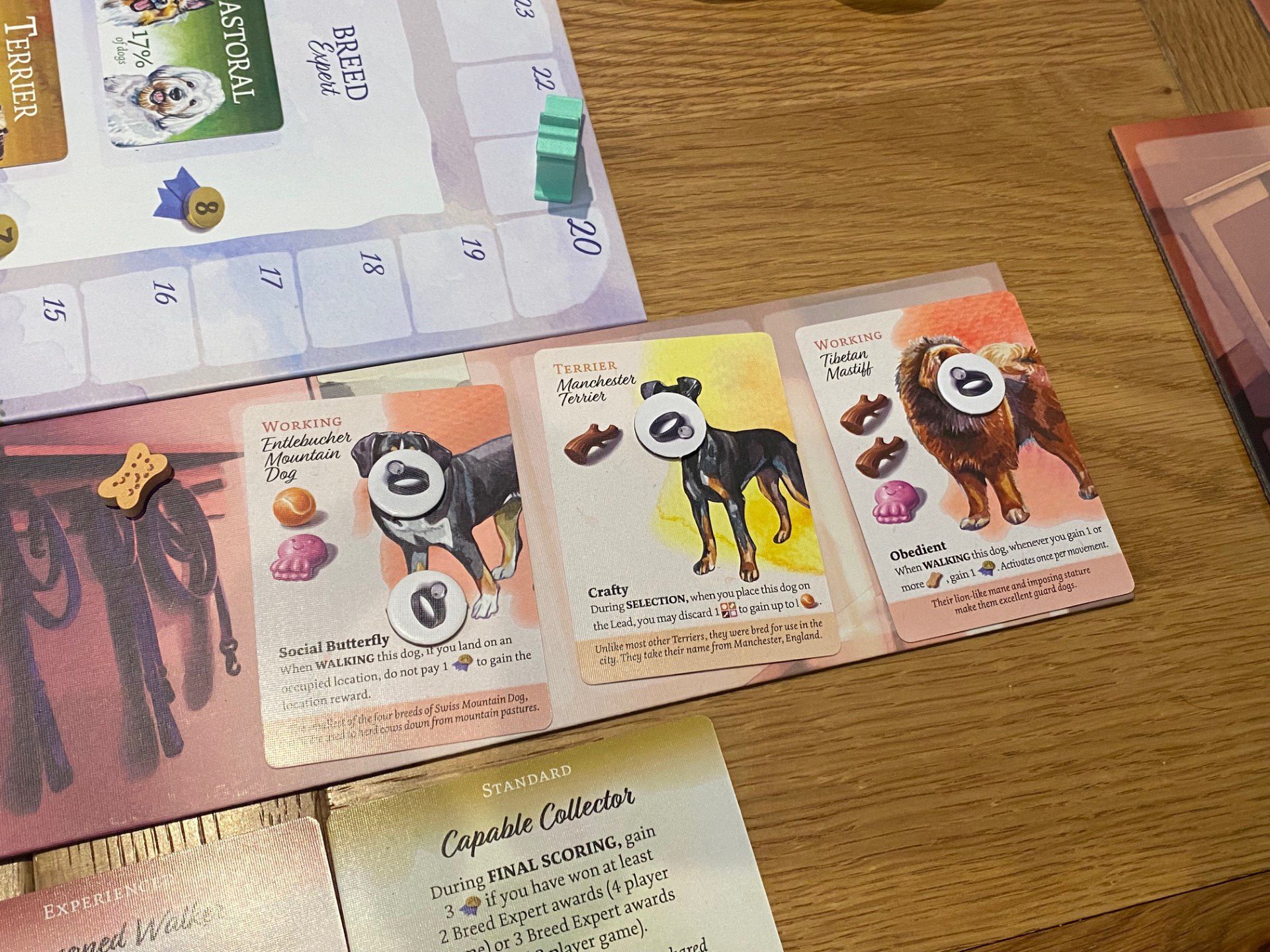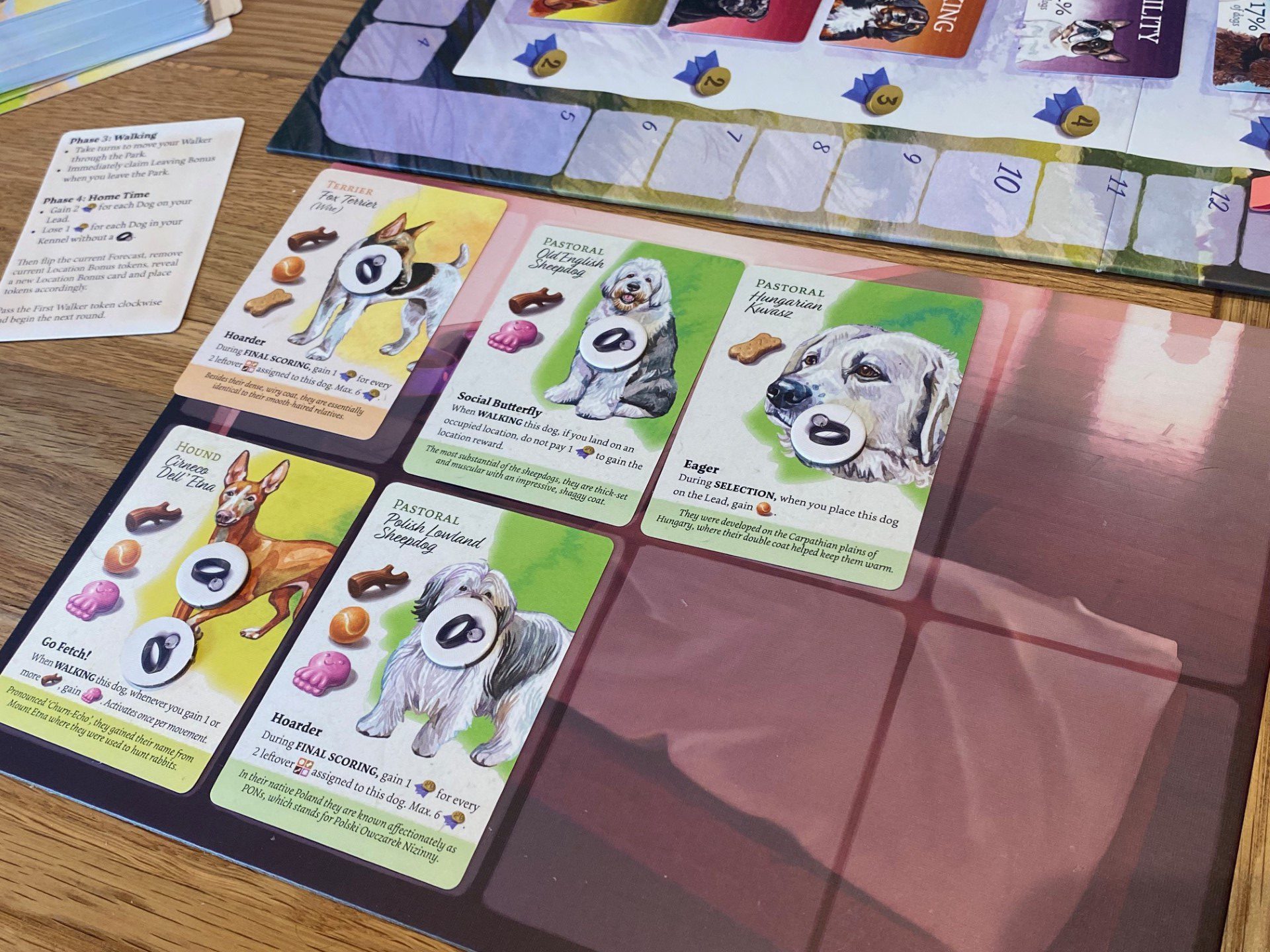Dog Park is a breezy walk through the park
In Dog Park, players take on the thematic role of a professional dog-walker, and must build out their collection of customers (dogs) and focus on specific collections to score loads of points. With bidding, set collection, variable objectives and a little bit of racing in-between, Dog Park is an attractive and straightforward game with lots of variety in both gameplay and artwork.
The version of Dog Park pictured in this review is the Collector’s Edition of the game — but that in itself is a bit of a spoiler because I was actually sent the “basic” version to review, and enjoyed it enough to want to upgrade it at my own cost. The only differences between the collectors and basic versions of Dog Park are the components, the storage trays and the fact that the Collectors Edition also comes with two expansions bundled in — these add European Dogs and Famous Dogs to the roster, and add more variety to the artwork, but nothing new in terms of mechanics.

During setup, each player chooses a coloured play mat, a dog and a walker figure in the matching colour and then takes a few resources to begin the game with. They will then place the central board, put their dog on the reputation track at space five, place out several cards (forecast, breed expert, bonus and dog) and then put out a few other tokens such as the round marker and a number of resources or tokens as specified by the bonus card.
In short, the forecast cards present a special rule or scoring opportunity for each of the four rounds, the breed expert cards represent the most valuable types of dogs in this game, whilst the bonus card just dictates what bonuses will be placed where in the dog park. The dog cards (which are the most important, of course) are drawn and placed in spaces based on the number of players (one per player, except at two players where there will be a third, along with a dummy player).

After this, each player is dealt one simple and one expert objective, of which they will keep one and discard the other. They will also take a special dial piece in their colour, and this will allow them to secretly select a bid value (up to five) for the recruit phase of the game. When set up, Dog Park looks lovely on the table, with fantastic watercolour art in light and mostly natural colours such as green, bluey grey and soft purple. It’s a lovely aesthetic, and before we even get to the dogs, it’s enough to put the players in a good mood right from the off.
That mood can change quickly though, because the first two phases of each round involve bidding for dogs — which is done by using the dial I just mentioned to place a bid. This is resolved in turn order, with the first player setting their dial and then placing their walker miniature onto the dog they wish to bid for. The following players will all do the same, and players “earlier” in the queue will win tiebreakers. Once all bids are set, the dials are revealed and anyone who wins a bid for any value must reduce their reputation by that value. If a player (or players) lose a bid, they will be moved to the dog (or dogs) that remain after all winning bids (whether completed or not) are completed. In this way, if you end up with a dog you didn’t want, it won’t cost you any reputation.

This process is repeated twice at the start of each of four rounds and at the end of the game everyone will have eight dogs. Each of the hundreds of dog cards has unique art and a unique breed — sometimes including interesting flavour text — but there are only 7 groups of dogs (terriers, hounds, toy dogs for example) into which every dog will fall. Most dogs have an ability printed on them as well, and again, these abilities are repeated on many cards across each group of dogs, so whilst Dog Park may have comparisons to say Wingspan, it is nowhere near as unique in terms of the variety of game-affecting rules the players need to manage.
With dogs now in the kennel, the next phase of the game is the selection — where dogs are chosen to go for a walk. Players can choose up to three dogs to walk by taking them to their “lead board” and paying their walking cost as shown on the dog. For example, a treat and a stick, or a ball. When this cost is paid, the dog receives a lead token (which may trigger points later, or possibly abilities) and is then considered to be on the walk with you during the next phase.

The walking phase is where the players line up and move up to four spaces along the field. If a player stops on the same space as a bonus token, they may choose to take that bonus (sometimes a resource, sometimes the ability to cycle through the dog deck, or even swap a dog). If a player lands on the same space as another player, they must either pay a reputation to use the bonus, or forgo that bonus. The first player to leave the park will gain reputation, whilst the last will lose it – so whilst this phase is fairly short and the walk can be over in three moves, there is a fair bit to think about (albeit still in context that this is a fairly light game).
After the walk, players resolve scoring for dogs on the lead board — gaining two reputation points for each. Dogs in your kennel without a lead on them (meaning they have not been walked either this round or prior) will now score minus one reputation as well, meaning that if you’re going to take a dog, you really should be walking it. The thing is, because walking a dog costs resources — and resources in Dog Park are tighter than you might think — there is actually quite a fine balancing act to do here.

At the end of the game, players will use a scorepad to calculate their overall score — adding together their reputation points, the points earned for breed expert cards (based on who has most of each type), any points earned from dog abilities, any objectives (if achieved) and then finally one point for every five resources you have left over.
There are a few things that make Dog Park interesting, the first of which is how it balances a variety of different mechanics alongside a very clear structure and a generally light weight. Bidding is a core mechanism that can be complex when the decision space is too broad, but in Dog Park, the information is clear — you can see what dogs you have and what your opponents have, you can see what breed expert cards will score best and you can bid accordingly. The only hidden information is your own objective, and if you can manage to align that with some of the scoring methods open to everyone, but which no one else is focussed on, you’re onto a potential winner.
I also like the walking phase, which shares some of its ideas with games like Tokaido. Resources are scarce in Dog Park, and being able to stop at every space to collect “stuff” is great, except that your opponents will finish first and not only will they gain reputation, but you’ll actually lose it if you finish last. That’s not a position you want to be in when you know the next phase will involve bidding reputation and losing even more.

Thankfully, the dog cards offer yet another simple-to-process way to think your way out of the situation. Some bonuses on dogs allow players to generate extra resources when that dog is walked or occasionally for some other reason, so whilst it might be good to focus on end game scoring with your later dogs, in the earlier game, you want to make sure you are gaining at least a couple of extra resources with every walk.
Taken together, Dog Park flows really nicely. Each phase of the game is centred on a different mechanic, but it is both thematically and mechanically clear. You bring dogs to your kennel based on your reputation. You give them the treats and toys they like and then walk them. Then you bring them home tired and score points accordingly. Dog Park is so straightforward that I am playing quite competitively against my eight and six year old daughters — occasionally leaving out the hidden objectives, but nonetheless, that tells you how straightforward this game is.
But that can be a downside at times as well. If there are two criticisms about Dog Park, they would probably be that firstly, players have little control over what dogs come out for selection, and even over four rounds, you’ll only see between 32 and about 40 dogs (the latter being at the very most, and only if the acton to replace dogs is triggered a lot) which out of a deck of 200+ is not many. I think this is why the designers made the dogs quite common in terms of abilities and costs, but still, it can affect both hidden objectives and breed expert scoring in ways that eurogamers (who like to have control over everything) won’t enjoy.

Secondly, Dog Park can actually feel quite mean in respect to its resource distribution, which is a problem that compounds slightly with the first issue. In effect, if you do not get dogs that generate resources in the first round, and let’s say you also act late in player order (meaning you move in the park later) you can be frozen out for resources quite quickly. No resources means fewer dogs can go to the park with you, and soon you can be quite behind – I wasn’t expecting this when I first started playing Dog Park, and I do think it is slightly out of keeping with the lightness of the game overall.
With those minor criticisms aside, I really like Dog Park and so do my kids. As long as the people at the table have an interest in dogs, you can pitch Dog Park to just about anyone of any age or level of experience. Decisions in the game are interesting and linked to what you want to do rather than what the game will allow you to do, and despite the variety of mechanics, it’s a very straightforward experience. Overall, a great looking game that plays well and offers fun and excitement for all the family.
You can find Dog Park on Amazon.
Comments are closed.